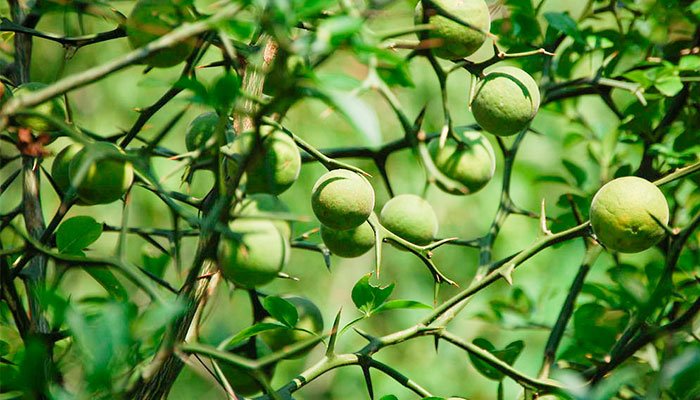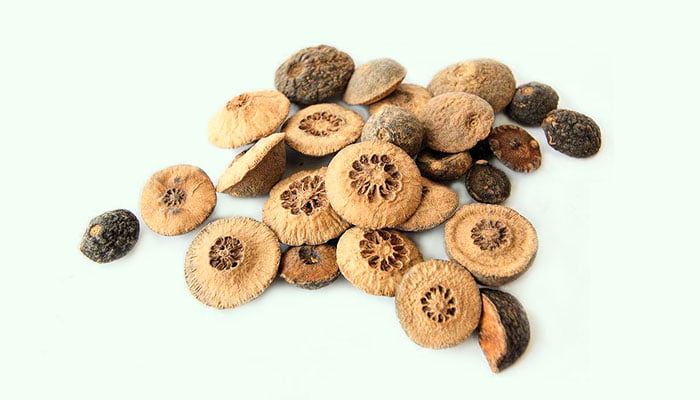What Is Zhi Shi
Zhi Shi commonly known as Fructus Aurantii Immaturus is the immature fruit of Citrus aurantium L. and its cultivars, or Citrus sinensis Osbeck, which is an evergreen small tree belonging to the family Rutaceae. It is a relatively practical and common Chinese herbal medicine, which first appeared in <Shennong Ben Cao Jing> in the late Western Han Dynasty (around 100 BCE).
Citrus aurantium L. commonly known as Bitter orange, Sour orange, or Seville orange is a common fruit tree. They are native to East Africa, the Arabian Peninsula, Syria, and Southeast Asia, and are now found throughout the Mediterranean region and elsewhere, including California and Florida. Their fruit is usually utilized as a flavoring and acidifying agent for food.
In 2004, after ephedra products were banned by the FDA for weight loss due to their safety concerns, C. aurantium quickly became an alternative. It contains p-synephrine, a phenylethanolamine type alkaloid, which is chemically similar to adrenergic agents, as appetite suppressants. The National Collegiate Athletic Association (NCAA) has placed “synephrine (bitter orange)” on its current list of banned drugs, listing it as a stimulant [1].

Citrus sinensis Osbeck is commonly known as orange or sweet orange. They like warmth, are not cold hardy, and are shade tolerant. They are suitable to be planted in deep soil with loose, fertile, well-permeable, and breathable soil. They are native to southeastern China and are now widely distributed in tropical fruit regions around the world.
From May to June, people gather the young fruits that fall naturally from Citrus aurantium L. and its cultivars or Citrus sinensis Osbeck, remove impurities, cut them in half crosswise, dry them in the sun or dry them at low temperature, cut them into thin slices, use them directly, or stir-fry them with bran, and make them into Chinese herbal medicines.
Zhi Shi contains rhoifolin, rhoifolin-4′-glucoside, luteolin-7-O-neohesperidoside, neodiosmin, 6-C-β-glucosyldiosmin, tangeretin, nobiletin, 5-demethyl nobiletin, sinensetin, natsudaidai, rutin, nicotiflorin, naringenin, hesperetin, hesperetin-7-O-β-d-glucoside, isosakuranin, narirutin, eriocitrin, hesperidin, methyl hesperidin, eriodictin, naringin, neoeriocitrin, poncirin, neohesperidin, melitidin, brutieridin, synephrine, N-methyltyramine, N-acetyloctopamine, N-benzoyl tyramine, uracil, thymidine, adenosine, coumarins, Limonoids, Phenols, phenolic compounds, phenyl compounds, phenyl glycosides, cyclic peptides, amino acids, and polysaccharides.
Generally, Zhi Shi with the black and green outer skin and strong aroma are preferred.
According to the Chinese Pharmacopoeia, the medicinal nature of Zhi Shi is slightly cold, with a bitter, pungent, and sour taste. It has a certain therapeutic effect on the pathological changes of the spleen and stomach meridians.
In Traditional Chinese Medicine, it is often used to relieve stagnant qi and remove food retention, reduce phlegm and abate distension and fullness, and treat indigestion, nausea, abdominal fullness and distention, constipation, diarrhea, dysentery, tenesmus, obstruction of qi in the chest, fullness and oppression in chest and epigastrium, chest pain, epigastric fullness, loss of appetite, gastric dilatation, gastric prolapse, uterine prolapse, prolapse, acute gastritis, chronic gastritis, reflux gastritis, acute enteritis, chronic enteritis, chronic cholecystitis, gallstone disease, chronic liver disease, heart failure, coronary angina, ringworm, and foot infection.
There are over 760 traditional Chinese medicine prescriptions that contain it, such as Zhi Shi Dao Zhi Wan, Da Cheng Qi Tang, and Si Ni San.
Benefits
- Anti-inflammation, inhibiting histamine- and dextran-induced edema in rats [2].
- Anti-oxidation, scavenging DPPH, OH, and ABTS radicals, reducing ferric ion (Fe3+) to the ferrous ion (Fe2+) [3].
- Inhibiting the aggregation of platelet and red blood cell in both healthy and blood stasis rats.
- Relieving stagnant qi and removing food retention, treating abdominal fullness and distention caused by stagnation of intestines and stomach.
- Treating constipation and abdominal fullness and pain caused by the accumulation of heat in the intestines and stomach.
- Treating diarrhea and tenesmus caused by damp-heat.
- Reducing phlegm, abating distension and fullness, treating obstruction of qi in the chest, fullness and oppression in chest and epigastrium, and chest pain caused by qi obstruction due to phlegm obstruction, or retention of phlegm-heat in the chest.
- Treating visceral prolapses such as gastric dilatation, gastroptosis, uterine prolapse, and anal prolapse.
synephrine tended to bind with the β-3 receptor, thus promoting lipolysis. - It contains neohesperidin, which decreases fasting glucose, serum glucose, and glycosylated serum protein in diabetic KK-Ay mice. In addition, it also can decrease serum triglycerides, total cholesterol, leptin level, and liver index in the KK-Ay mice [4].
- Its aqueous extract strengthens bowel movement in cathartic colons via increasing the expression of 5-HTR4 and neurofilament-H, and alleviates slow transit constipation [5].
- Its hot water extract significantly inhibited gastric ulcers and hemorrhagic lesions caused by ethanol and aspirin. Its volatile oils can prevent the formation of pyloric ligation ulcers and reduce the secretion of gastric juice and pepsin activity.
- Intravenous administration of its alkaloid aqueous solution to rats and dogs can cause a significant increase in their blood pressure.
- Its ethanol extract protected against acetaminophen-induced liver necrosis by inhibiting the p53 up-regulated apoptosis regulator and reversing the disorder of liver lipid metabolism [6].
- Its carbonized product reduced serum uric acid by inhibiting xanthine oxidase activity in hyperuricemia rats and inhibited xanthine oxidase activity in vitro. It improved gouty arthritis induced by monosodium urate crystals in vivo and in vitro [7].
- Its extracts have a good inhibitory effect on a variety of HT-29 cells, SMMC-7721 cells, H22 cells, BcaP37 cells, AGS cells, U937 cells, HepG2 cells, Thle2 cells, HepG2 cells [8].
- The light/dark box test found its essential oil exhibits anxiolytic-like activity mediated by 5-HT1A receptors and reduces cholesterol after repeated oral treatment [9].
Combinations
- It can be used in combination with Shan Zha (Hawthorn Fruit), Mai Ya (Fructus Hordei Germinatus), Shen Qu (Medicated Leaven), etc. to treat abdominal fullness and distention caused by retention of food leading to stagnation of qi.
- It can be used in combination with Da Huang (Radix et Rhizoma Rhei), Mang Xiao (Natrii Sulfas), Hou Po (Magnolia Bark), etc. to treat constipation and abdominal fullness and pain caused by the accumulation of heat in the intestines and stomach.
- It can be combined with Bai Zhu (Rhizoma Atractylodis Macrocephalae) to treat post-eating abdominal fullness and distention caused by weakness of the spleen and stomach.
- It can be used in combination with Huang Qin (Radix Scutellariae), Huang Lian (Rhizoma Coptidis), etc. to treat diarrhea and tenesmus caused by damp-heat.
- It can be used in combination with Xie Bai (Allii Macrostemonis Bulbus) and Gui Zhi (Ramulus Cinnamomi) to treat obstruction of qi in the chest, fullness and oppression in the chest and epigastrium, and chest pain caused by phlegm turbid retention, and inactivity of thoracic yang.
- It can be used in combination with Huang Lian (Rhizoma Coptidis), Gua Lou (Fructus Trichosanthis), Ban Xia (Pinellia Rhizome), etc. to treat distending fullness in the chest, chest pain, stomach distension caused by retention of phlegm-heat in the chest.
- It can be used in combination with Bai Zhu (Rhizoma Atractylodis Macrocephalae), Ban Xia (Pinellia Rhizome), Huang Lian (Rhizoma Coptidis), Dang Shen (Radix Codonopsis), Gan Cao (Licorice Root), Fu Ling (Poria), Hou Po (Magnolia Bark), etc to treat epigastric fullness, loss of appetite, and indigestion caused by intemperance diet, or stomach disorders.
- It can be used in combination with Huang Qi (Radix Astragali), Bai Zhu (Rhizoma Atractylodis Macrocephalae), etc. to treat gastric dilation, gastroptosis, uterine prolapse, anal prolapse, and other visceral prolapses.
Side Effects
- Zhi Shi is likely safe when used orally in amounts commonly found in foods.
- However, studies also suggested that Zhi Shi could cause damage when used in high doses. A high dose of Zhi Shi caused high and fast elevation of blood pressure (over 180–200 mmHg), temporary ectopic rhythm, and anuria of anesthetized dogs [8].
Precautions and Warnings
- The dosage of Zhi Shi should be controlled between 3-10g.
- It can be made into decoctions, pills, or powdered for external use.
- People who are allergic to Zhi Shi should not take it.
- Patients with weakness of the spleen and the stomach should not take it.
- Pregnant women should use it with caution.
- Breastfeeding women, children, and elderly patients with the weak constitution should take it under the guidance of a doctor.
- The unprocessed Zhi Shi is recommended for relieving stagnant qi and reducing phlegm, and the stir-fried Zhi Shi with bran is more moderate in its medicinal properties and is recommended for the treatment of indigestion.
